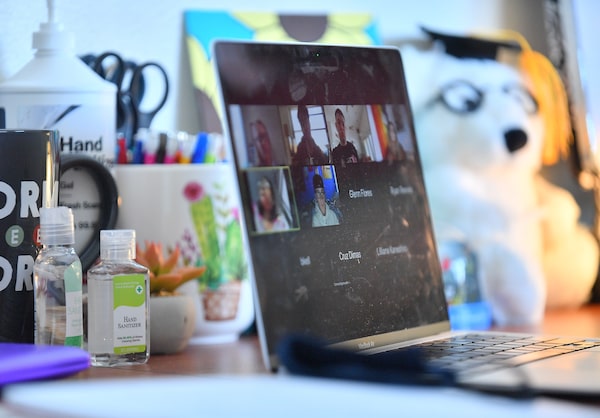Hi, I’m Samantha Edwards, an editor at The Globe and Mail. Welcome back to Lately, The Globe’s new tech newsletter where every Friday morning I break down the week’s biggest tech stories and how they intersect with – and even change – our world.
In this issue:
⏲️ The U.S. has started the clock for a potential TikTok ban. What does that mean for Canada?
💸 A glimpse into the inner workings of a crypto scam
🤖 Canada’s screenwriters say: No robots in the writers’ room
⚡ When Zoom layoffs go viral
Biden tells TikTok: Divest or get banned
ByteDance has nine months to sell TikTok to an American entity, or face a ban in the U.S.Dado Ruvic/Reuters
On Wednesday, President Joe Biden gave TikTok’s owner ByteDance an ultimatum: Either sell the platform to an American company within nine months – or get banned in the U.S. Lawmakers say TikTok is a threat to national security, arguing ByteDance, a Chinese company, could use the app to spread propaganda or access sensitive data. TikTok chief executive officer Shou Chew said the company will file a court challenge.
A few people have signalled interest in purchasing TikTok, which is valued at more than $50-billion. They include Donald Trump’s former treasury secretary Steve Mnuchin, Canadian businessman and Shark Tank judge Kevin O’Leary, and Chris Pavlovski, CEO of the MAGA crowd’s preferred YouTube alternative Rumble.
In Canada, Ottawa ordered a national security review of TikTok last September and the app has been banned from federal government devices. Prime Minister Justin Trudeau hasn’t commented on the U.S. bill yet, but it’s likely that Canada will follow the lead of the Americans, says Philip Mai, co-director of the Social Media Lab at Toronto Metropolitan University. For now, even if TikTok was banned in the U.S., it would still be available in Canadian app stores.
In the next few weeks, we’ll see how Beijing responds. Mai says the Chinese government could put a ban on ByteDance selling certain technologies, i.e. the sale of TikTok could go through, but not its secret-sauce algorithm. However, a sale without the algorithm would drastically lower TikTok’s value.
“More than likely, Beijing will make some noise – it’s unfair, it’s illegal – but in the end, they’ll let it go because if they don’t, they’ll be hurting their own people because now the value of the asset they have will go down,” Mai says.
‘I want to be like bitcoin jesus, but better lol’
Court documents provide a glimpse into a crypto scam.Dado Ruvic/Reuters
In 2019, Gerald Cotten, the young co-founder of Canada’s largest virtual currency exchange QuadrigaCX, died while on his honeymoon at the age of 30. After his death, the exchange collapsed into bankruptcy and thousands of users were unable to access their money.
Now new court documents filed in the B.C. Supreme Court provide the first glimpse into how the Quadriga crypto scam unfolded. The documents include chat transcripts from 2014 between Cotten and QuadrigaCX’s other co-founder, Michael Patryn, discussing how they could squeeze the most money out of their new company, taking it public in a “pump-and-dump” scheme or using proceeds to “look at scam opportunities.”
Reflecting on his own ownership stakes in Quadriga, Cotten wrote to Patyrn about his own saintly ambitions: “I want to be like bitcoin jesus, but better lol.”
Canada’s screenwriters authorize strike
Members of the Writers Guild of Canada rally in support of U.S. screenwriters in June, 2024.Tijana Martin/The Canadian Press
Last week I wrote about the six months of negotiations between the Writers Guild of Canada and the Canadian Media Producers Association, with AI protections and greater pay being the major sticking points. On Thursday, the WGC announced that 96.5 per cent of its voting members were in favour of authorizing a strike. The guild said it would not immediately strike, but would use the results as a bargaining tool.
Get Ready With Me to Get Laid Off

Layoffs should be like break ups: always in person.Sam Wasson/Getty Images
You’ve probably seen Get Ready With Me videos on TikTok, where a person does their makeup, chooses an outfit or perhaps whips up a photogenic matcha latte. Now a new twist on this style of post is popping up: Get Ready With Me to Get Laid Off. As layoffs over Zoom become more common – the telltale warning sign being an out-of-the-blue calendar invite with HR – some people are filming the hours leading up to their layoffs, and sometimes even the deed itself. On today’s episode of Lately, host Vass Bednar speaks with Amanda Hoover, a staff writer at Wired, about the reality of remote layoffs and what happens when they go viral.
What else we’re reading this week:
How Montreal’s RodeoFX clawed its way to the top of the visual-effects business (Report on Business Magazine)
What happens after your country runs on 99 per cent renewable electricity? (The Verge)
Old Macdonald had a drone. Inside farming’s tech boom (The Walrus)
Adult Money

$169.95 is a ridiculous amount. And yet, this mug has made my life a lot better.Supplied
In my previous two Adult Money columns, I wrote about aspirational items I thought would make me feel more like an Adult – a chic work tote bag, a walking pad desk set-up – and consequently catapult me into new wild heights of success. Reader, I’m sorry to report I haven’t purchased either yet. I’m just not a big online shopper. I’m more of an “add a half dozen things to my shopping cart and forget about it until I start getting targeted ads on The Globe’s website” type of person.
However, this week I’m here to talk about something that has actually made my life better. Last year for my birthday, my brother who works in the startup world (the truest tech bro, if you will) gifted me an Ember temperature-controlled mug, which has a built-in heater that keeps your coffee piping hot for up to 1.5 hours. The 10-ounce mug is not cheap. Right now it retails for $169.95, which is a ridiculous amount. But as a slow drinker, it has significantly improved my morning routine.
Culture Radar
Brian Eno gets the AI treatment

No two screenings of Eno will be the same.Supplied
Brian Eno is a glam rock pioneer, the legendary producer of David Bowie and Talking Heads, and the godfather of ambient music. Eno’s sparse music was my go-to soundtrack for late-night studying and stress writing on deadline. If Eno never existed, we’d never have “lofi hip hop radio - beats to relax/study to.”
The new documentary Eno, which is playing this month at the Hot Docs film festival in Toronto, chronicles the British artist’s eclectic life. But not always in chronological order. The doc uses a custom-built algorithm to randomize the scenes, meaning every screening is different. Director Gary Hustwit worked with programmer Brendan Dawes to create the generative software, which rejigs the sequence of archival footage and interviews throughout the doc’s two-hour runtime.